English Bulldog: breed description, life expectancy and content
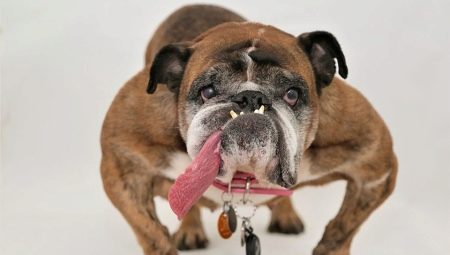
The English Bulldog is a stocky, powerful dog with pronounced muscles. A dog of this breed is distinguished by a phlegmatic character, exceptional intelligence and a love of cleanliness.
It is for these qualities that the animal received the nickname "English gentleman".
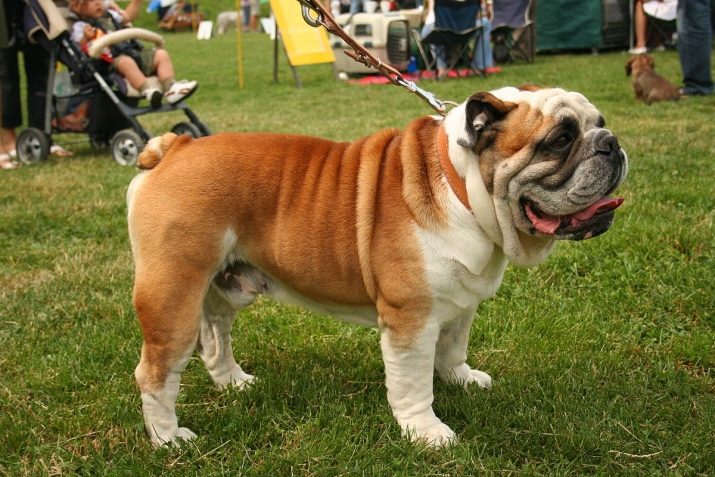
Origin story
In the XVII-XIX centuries. In Britain, the Old English Bulldogs, originating from the North Caucasian Alans, as well as the Central Asian mastiffs, became widespread. These dogs became the progenitors of modern "Englishmen".
There are great similarities in exterior between modern dogs and their ancestors, and the main difference lies in the nature of the dogs. Old Bulldogs were quite angry and aggressive animals, which were widely bred for baiting while hunting. It was these dogs that were exhibited for the amusement of the crowd, pitting against bulls, brown bears and even lions. Among the first representatives of the breed, there were dogs of a wide variety of colors and sizes, dogs were distinguished by the peculiarities of the jaws.
"Natural selection" was carried out by bulls, which in the process of fighting destroyed the weak and unsuitable for fighting animals. People watched the battle of dogs with large animals, and then developed in dogs all those characteristics that contributed to the formation of the perfect fighting breed. So, at the very beginning of the struggle, the mastiffs grabbed the enemy by the scruff of the neck, neck or ear, and then tried to knock him down. But because of their weight, the dogs often fell under the hooves of angry bulls or on the horns, which most often ended in the death of the dog.

And the "butcher dogs", thanks to long-term selection and selection, were much more successful in defending themselves from the enemy. They used their "signature trick" and tried to grab the bull by the nose. For the giant, this is perhaps the most sensitive place, so when the bulldog was captured, the will of his rival was completely paralyzed. Most often, the bull in such a situation lost the desire for resistance and he fled from the ring, at that moment the fight was considered over, and the dog was declared the winner.
In 1835, bulldogging was banned by law, and the large number of English bulldogs was "out of work", but this oblivion did not last long. Soon the fighting qualities of animals were again appreciated, and the dogs turned from fighting dogs into reliable guards and watchmen.
However, during this period, the population of bulldogs faced a new problem - animals began to mate with numerous dogs of other breeds, as a result, there were almost no purebred representatives of bulldogs left.

In 1858 the scale of the problem reached such a level that English dog handlers began to preserve the typical bulldogs. At the same time, they set themselves one more task - to breed less aggressive animals and eradicate their fighting characteristics. For the implementation of the tasks set across the UK, the selection of the calmest dogs began.
A year later, an exhibition was opened in Birmingham, where bulldogs of a "new" type were shown - by their temperament they were very different from the previously known dogs. Numerous visitors to the event could not help but appreciate the extremely high professionalism of geneticists and breeders, and the reviews about these dogs were extremely enthusiastic.
In 1873, the English Bulldogs were finally recognized by the world canine community, and at the very beginning of the 1880s, breeders from other countries drew attention to the breed. Nowadays, it is already difficult to say for sure what the secret of the rapidly growing popularity of the new bulldogs was.
Perhaps dog breeders were attracted by their funny appearance, or maybe a calm and balanced character, but the fact remains - the new breed was liked by breeders all over the world and today remains one of the most popular.
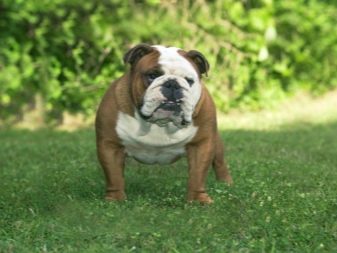
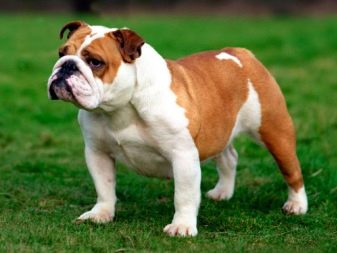
Description and breed standard
The English Bulldog is a medium sized dog. It is a sleek-haired animal, stocky and very downward. The head is very large - its coverage is usually equal to the height of the dog at the withers. The height of the animal varies depending on its gender. So, males usually grow up to 36-41 cm, and females up to 30-36 cm. The weight of males is about 20-25 kg, the mass of bitches is close to 16-20 kg.
If we compare the size of the Englishman's head with the general dimensions of the dog, then we can say that the head is very large, but at the same time it does not in an amazing way violate the existing proportions. Therefore, in general, the animal does not look deformed. The muzzle of dogs is wide, depressed and blunt, slightly curved upward. The forehead in dogs of this breed is flat, while not particularly protruding above the muzzle.
Deep folds are discernible on it, a groove is visible up to the top of the skull.
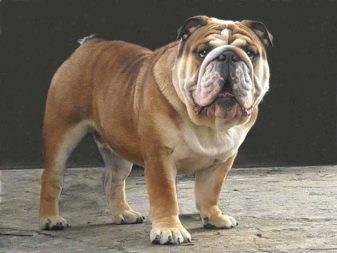

The frontal bones of the skull are embossed and slightly convex in projection, they are characterized by a square shape and noticeable width. The jaws are strong. The lower one protrudes slightly forward and is slightly bent upward. 6 incisors grow on it, which are located in a straight line between the canines, while the latter have a fairly clear arrangement.
The eyes are set low, at a small distance from the auricles, usually they are placed at an angle of 90 degrees relative to the groove. The position of the eyes is widened, while the outer edges are inside the outer part of the cheeks. The size of the eyes is average, the shape is standard, round. They do not sink into the eye socket, and they cannot be called convex in any way.The iris is usually dark in color, almost black, the squirrels are not visible.
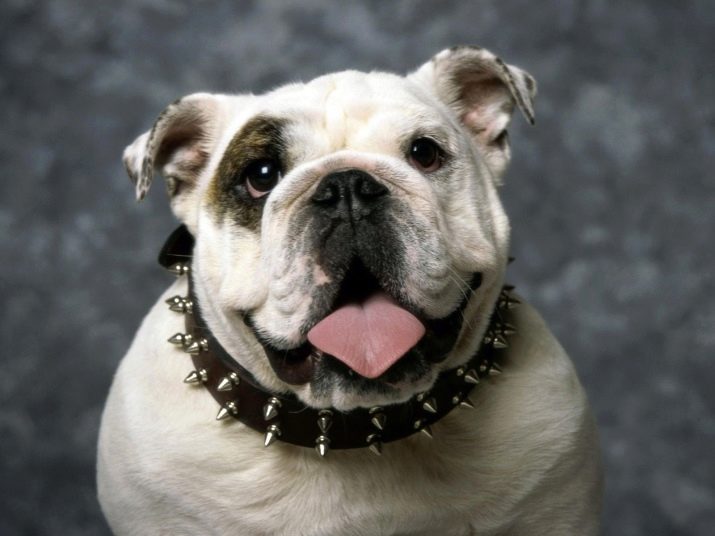
The ears of the "Englishman" are characterized by a very high set at a distance from the eyes. Their shape resembles a bud - they are brought back and hang down to the back, while the front upper edge has a pronounced curvature both to the outer edge and inward.
The lobe of the nose in animals of this breed is usually large and rather wide, usually it seems to be drowned between the eyes of the dog. The color is pure black, without any specks of brown, reddish or sandy tint. The nostrils have the same characteristics, they are usually open, between them a vertically located furrow is clearly visible.
The lips are thick, at the same time pendulous and very deep, thanks to this the jaw completely closes on the sides, in front of this there is no, here only the teeth of the animal overlap.
The neck of the English Bulldog is of medium length, but very thick, muscular and strong. A fold slightly convex around the neck forms the so-called dewlap, in other words, the second chin, it stretches from the lower jaw exactly to the chest. In accordance with the official breed standard, the length of the neck should be in harmony with the size of the dog in general and the size of the head in particular.
If the animal has a too short neck, then this is far from the best effect on the exterior, in addition, it creates problems for the dog with the work of the respiratory system.

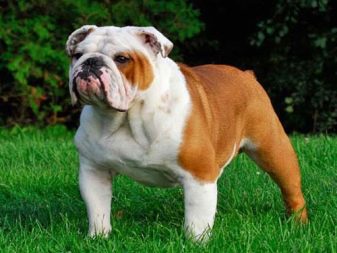
The animal's body is lean and squat. The topline in the lower part is slightly lowered, then rises slightly to the lumbar region, becomes slightly above the level of the withers, then smoothly rounds and goes down near the tail. Due to this peculiar structure, the so-called "arch with a sail" is visible on the topline - this has become one of the distinctive characteristics of the English Bulldogs.
The back of the dog is short, but very powerful. In the shoulders, the bulldogs are wide, in the lumbar region the back is narrowed. The "English" chest is wide and rather deep, slightly rounded and slightly convex on the sides. The dog's belly is tucked up, not saggy. The tail is low set, usually straight near the base. The back and front legs of the Bulldog are very powerful, large, covered with muscles.
The outer line is slightly curved, but at the same time, the bones are straight, they do not have any curvature or bends. The front legs are slightly shorter than the hind legs, but the back of the dog does not look longer than it actually is. Also, such a structure does not interfere in any way with dogs in the manifestations of their physical activity.
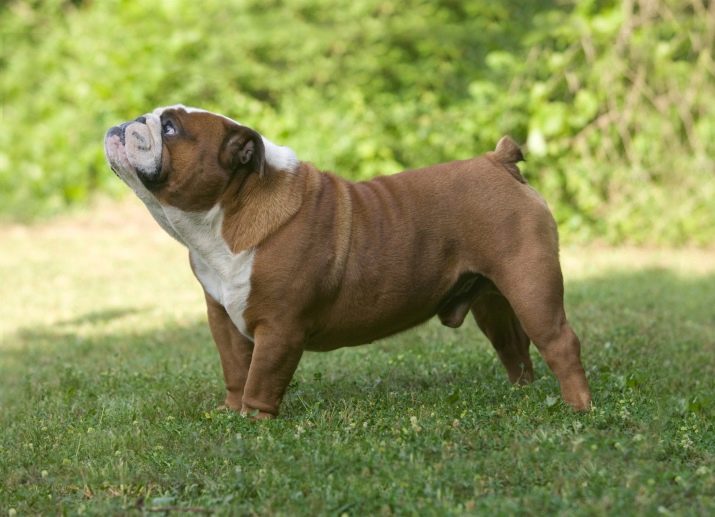
The shoulders are also broad, the muscles are well developed. At the same time, they are oblique and even sloping, the elbows are low and slightly spaced from the ribs, the pasterns are straightened, shortened and rather massive. Both the front and the hind legs are distinguished by the outward turning characteristic of this breed, the difference between them is reduced only to the fact that the front ones are usually of medium size, rather straight, and the hind legs are round and compact.
The gait of English Bulldogs is considered another sign of their difference - these dogs move with quick, small steps at their fingertips. The animal never raises its hind legs high during movement, therefore the "Englishman" shrugs a little.
For breed standards, stride length is of fundamental importance.
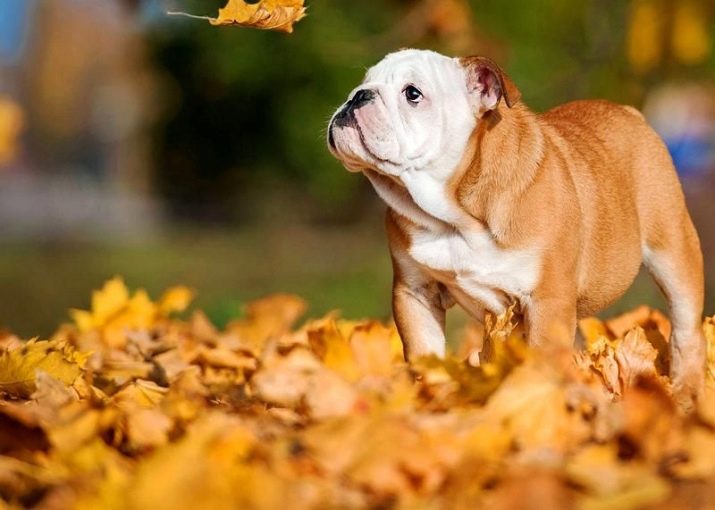
The coat of the English Bulldog is short, smooth and quite close to the body, the texture is delicate. The color is characterized by saturation of hue, purity and usually uniformity. The suits can be very different, most often dogs are brindle-red, as well as white, deer and piebald colors. A small whitish spot on the sternum is allowed in monochromatic and brindle dogs.
As a rule, the muzzle is slightly darker, which is why many say that the animal has a "muzzle". Any deviation from the above accepted standards is considered a flaw, defect or even a defect.The depth and severity of these deviations are judged by the degree of their impact on the daily activity and health of the animal.
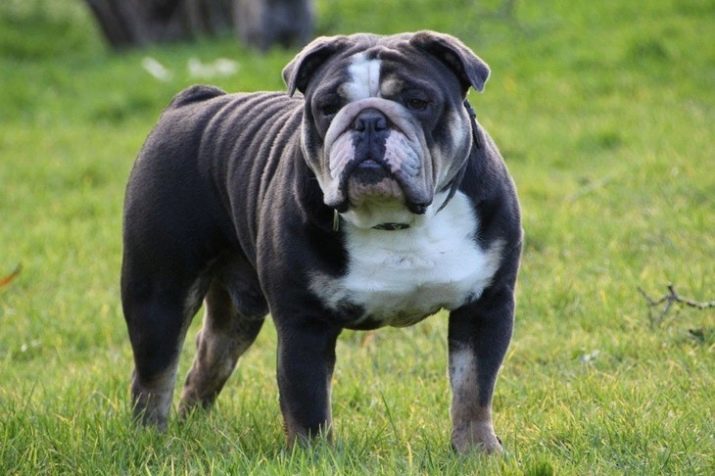
Character
Typically, representatives of the English Bulldogs perceive the people with whom they live as their own "pack". This dog is able to sincerely empathize with everything that happens in the house, showing exceptional dedication and sensitivity towards its owners.
This animal is considered an excellent companion for a person, it sincerely loves babies, realizing that they are the object of endless love of adults and tries to imitate them, showing the same warm feelings towards children. You can fearlessly leave the dog with children of all ages - the bulldog will become a reliable nanny, loyal playmate and protector for the children. This is a funny, reckless, but rustic animal. These qualities make the dog a truly indispensable participant in children's entertainment.
The animal seeks to demonstrate in every possible way its sympathy for the owners and expresses it in a very original way - joyfully jumping on people. It is advisable to wean the dog from this habit at an early age, otherwise over time, when the dog grows up and becomes quite weighty, he can injure the household by jumping on them at the most unexpected moment.
At the same time, English Bulldogs are quite smart, they have a sharp mind and perfectly understand what people want from them.
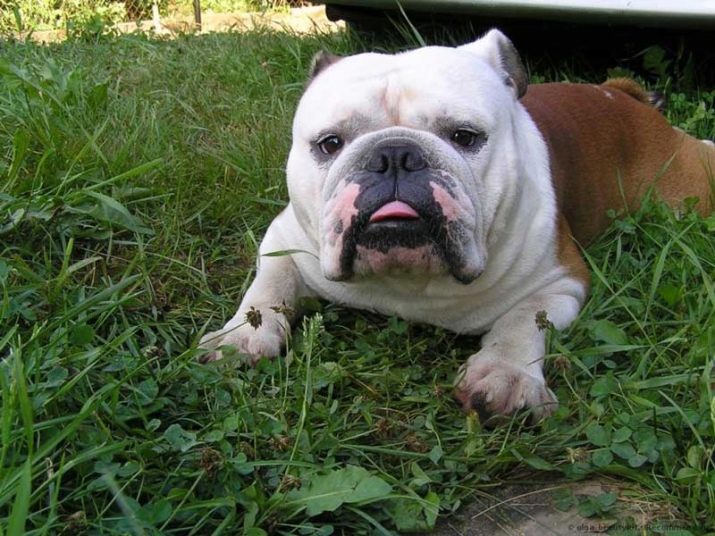
Representatives of this breed need constant communication and do not tolerate loneliness, if they are forced to be alone in the house for a long time, this has the most negative effect on the character of the pet - the animal becomes obstinate and sullen. By the way, stubbornness is one of the main characteristics of the English Bulldog.
Do not even try to force your pet to do anything with force or rudeness, you can only negotiate with these dogs... It is this respectable quality of the English Bulldogs that has made them the mascots of many sports clubs around the world.
Its owner is an English Bulldog loves unconditionally, perceiving it absolutely anyone: joyful or sad, lazy or cheerful, diligent or not very, that is, as he is. The dog in any situation is ready to protect its owner in case of danger. English Bulldogs, despite their formidable appearance and difficult genetics, have a very gentle, affectionate and good-natured character.
Wherein the dog is distinguished by poise, self-confidence, independence and exceptional independence.
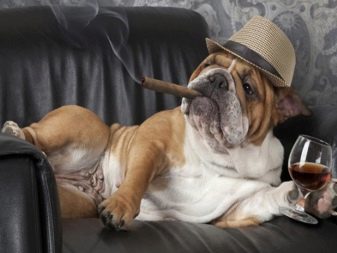

This animal is patient with any pets, dogs coexist quite peacefully with other dogs, get along well with cats, rodents and birds.
It should be noted that English Bulldogs are desperate couch potatoes. If representatives of many other breeds love to frolic and walk, then the favorite pastime of our "gentleman" is to lie on the master's sofa and doze, the dog can devote even the whole day to this. Long walks are not at all in his taste, therefore he prefers to satisfy all his needs close to home.
Please note - English Bulldogs love to chew on all sorts of things in the house. Most often, the owner's slippers, legs of chairs, tables and beds suffer. Therefore, from a very early age, you need to provide your dog with all the necessary chewing toys, otherwise the damage to your property will be quite noticeable.
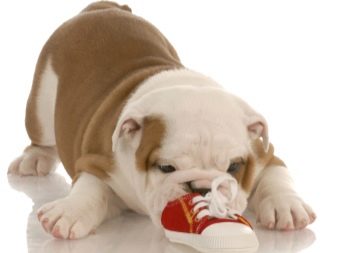
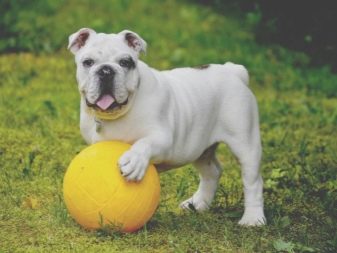
Advantages and disadvantages
Like any other breed, English Bulldogs have their own advantages and disadvantages. The pluses of these dogs include the following.
- Friendly nature. For a century and a half, geneticists have worked hard to breed a calm dog that does not show signs of aggression. These animals are distinguished by their devotion and love, they withstand all the games and pranks of children with incredible patience.The animals are easy to train and love to lie down for days on end. Of course, one should not expect perfect obedience from this dog, but you can always negotiate with it, and this is the undoubted advantage of the representatives of the breed.
- Owner protection. Of course, this dog cannot be attributed to ideal watchmen, but when strangers appear in the field of view, it always analyzes the situation, and if it seems to her that a loved one is in danger, then the bulldog will never be left on the sidelines. In this case, the animal is quite capable of emitting a formidable roar or even rushing at the offender.
- Unpretentiousness... This dog is completely unpretentious to the conditions of detention. A four-legged friend will feel great both in a large private house and in a small apartment. He does not need a lot of space, in addition, in the absence of owners, the dog does not tend to bark, and this is especially valuable for residents of apartment buildings.
- Friendly attitude towards other animals. If other pets live in the house, then the English Bulldog will never sort things out with them, although this dog will certainly strive for leadership, which it easily achieves.
- Low activity... The breed is optimal for people with a sedentary lifestyle. For a walk, this dog needs only a quarter of an hour a day; the animal does not need physical exercises and exercises on a specially equipped area.
- Unpretentiousness in nutrition. English Bulldogs are famous for their excellent appetite, while they are ready to eat almost everything that the owner offers them. However, this quality should not be abused. Representatives of this breed have a predisposition to allergies, so the animal's diet should be complete and balanced. It is very important in this situation not to overfeed the dog from your table and give up experiments in the field of nutrition.
- Accuracy... There is an opinion that these animals have increased salivation or unwillingness to satisfy their needs in the tray. But this is not so - in this matter everything depends solely on the nature of the individual and the characteristics of upbringing. Usually animals of this breed are extremely clean.
- Strong immunity. "Englishmen" are distinguished by good health, but care for the pet's immunity should be taken from the very first days. If a dog was raised in comfortable conditions, in compliance with the vaccination calendar, on a balanced diet and with proper skin and coat care, then it will grow strong, strong, without a tendency to all kinds of pathologies.
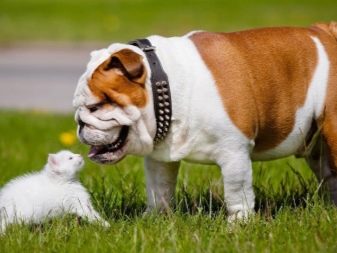
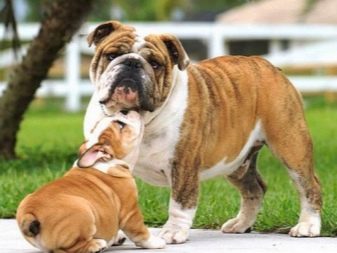
The disadvantages of representatives of the English Bulldogs include the following points.
- Prone to colds. The fact is that the structural features of the cranium have a strong effect on the respiration of an animal. It is not uncommon for English Bulldogs to have trouble breathing through the nose and through the mouth, which is a common cause of respiratory illness.
- Flatulence. Our "Englishmen" sometimes show not gentlemanly behavior. Since they breathe mainly through the mouth, they swallow too much air, which most often causes flatulence. The odor that comes out at the same time can be quite noticeable, so breeders need to either accept it or keep a high-quality air freshener nearby.
- Low thermoregulation. Everyone knows that the skin of dogs does not have sweat glands, so their cooling occurs with the help of a protruding tongue. However, due to physiological characteristics, English Bulldogs are not able to regulate body temperature in this way. If you do not keep an eye on your four-legged friend, then in hot summer weather he can get heatstroke and even die from overheating.
- Allergy tendency. Frequent cases of allergic reactions in some bulldogs lead to the fact that natural feeding is not suitable for these animals, so you have to feed the dogs with special therapeutic hypoallergenic mixtures.Keep in mind that in this case, the animal must have access to a drinking bowl with clean water around the clock.
- Reproductive system problems. As we have already noted, the traditional delivery of these dogs often ends in tragedy, since the small pelvis of the animals leaves almost no room for the natural birth of puppies. They are usually delivered in veterinary clinics by caesarean section. If you have no intention of breeding, then girls are best sterilized.
- Life expectancy. In English Bulldogs, it reaches 10-12 years old, but in practice there are few dogs that have crossed the 8-year age line. Cancer and cardiovascular diseases are the most common causes of early pet mortality; in addition, older dogs often suffer from pathologies of the musculoskeletal system, which often leads to lameness or even immobilization of the animal.
- Increased need for communication... These dogs, much more than some other breeds, need constant communication with their owners. At the same time, dogs strongly require frequent manifestations of love on the part of a person. If bulldogs do not receive such contact, they develop mental degradation, depression and other mental abnormalities on a nervous basis.
When buying such a puppy at home, you should keep in mind that you should always have time to play with your pet.
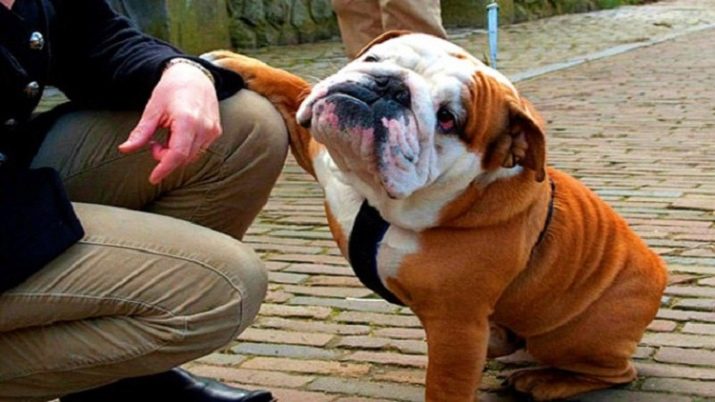
Varieties
Over the past century, English Bulldogs have spread throughout the world, leading inevitably to the emergence of new varieties of Bulldog dogs. The most active work on the breeding of new breeds of these dogs was carried out by French breeders, many experiments were carried out in Germany, Australia, New Zealand, Brazil, as well as in South Africa.
In many states, it was even decided to have their own national breed of bulldogs, as a result of which the English bulldogs turned into French, American and Australian ones.
However, these animals have rather serious differences from the English representatives, since each breed was bred for very specific goals and objectives, respectively, for them their own standard of exterior and character traits was created. From crossing the English Bulldog with other breeds, new varieties of dogs have appeared: Staffordshire Bull Terrier, Pit Bull and many others.
So, the bulldogs of American pit bulls were originally bred as fighting dogs, over time they showed such strong aggression that in some countries, for example, in Sweden, an official ban on keeping and breeding such animals was even adopted.
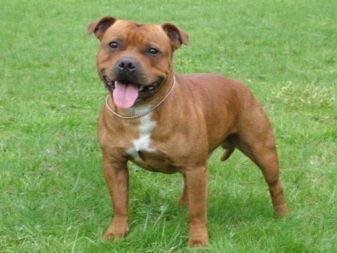
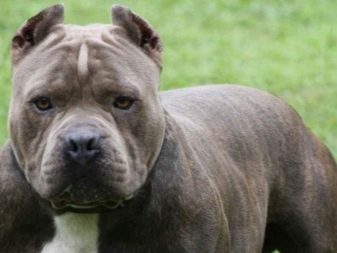
Maintenance and care
When purchasing a dog of this breed, you need to do the following.
- Arrange a separate place for her - this can be a dog's sofa or a special soft bed. It should be placed where household members cannot touch it with their feet, moving from one room to another. It is undesirable to equip the pet's sleeping place near the battery and in areas where draft often occurs.
- Purchase everything you need to maintain the normal functioning of your dog: feeders, drinkers, a brush, toiletries, a muzzle and other ammunition.
- Buy toys, as these cute pets love to chew on something, therefore, in the absence of toys, they will entertain themselves with damage to the owner's shoes, clothes and pieces of furniture.
- Take care of the optimal temperature conditions in the room.
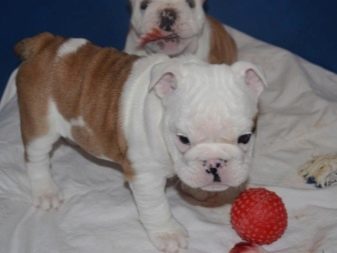
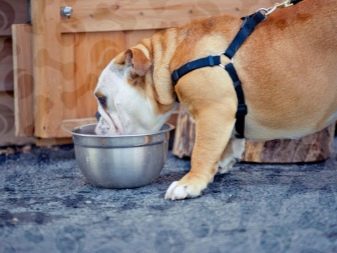
Let us dwell in more detail on the features of caring for an English Bulldog. In a way, it resembles caring for small children. But be sure that all the effort spent will return to you in the form of endless devotion and love of the animal.
The coat of this breed does not require any special care: a couple of times a week you need to comb it with a special brush... Molting in these dogs begins from about 8 months, during this period the procedure should be carried out daily, removing all dirt and dead hairs.
Particular attention should be paid to the folds on the animal's face - it is important to keep them clean and hygienic. To do this, they are wiped by alternating wet and dry discs.
The dog is bathed infrequently - 2-3 times a year or as needed, more frequent bathing procedures cause itching and dry out the skin of the pet.
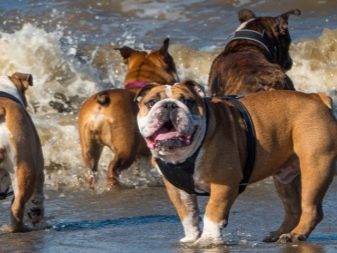
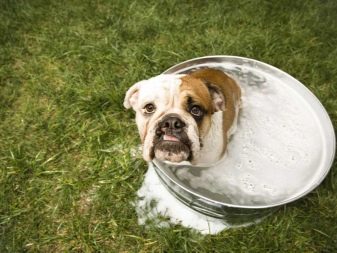
From the very first weeks of life, the animal should be taught to brush its teeth. For this, special brushes and pastes are used. From time to time, it is necessary to offer the dog special bones that help remove plaque. In no case should you forget about the area between the toes on the paws.... If you do not pay enough attention to them, diaper rash and redness are formed there. The English Bulldog is a real aristocrat, but any conditions of detention are great for him. The only thing that is important for the "Englishman" is coziness and comfort.
Buying a pet is always a very responsible step, which must be taken seriously. The acquisition of an English Bulldog is no exception. At the stage of choosing a puppy, it is important to clarify all aspects related to the health of the pet. It is important to find out how long such dogs live, how they need to be fed and how they should be kept so that the four-legged pet is cheerful and healthy. A very important place is occupied by pet vaccination.
Vaccinations should be done in strict accordance with the calendar drawn up by the veterinarian, but only for a healthy dog after preliminary treatment for worms and parasites.
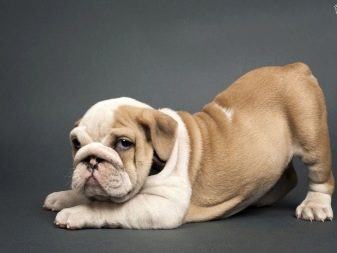
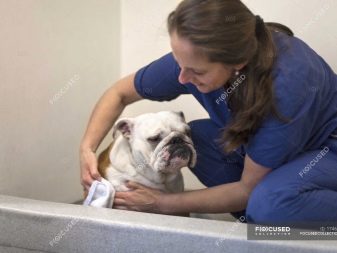
What to feed?
When deciding on the type of feeding of the English Bulldog, it is better to give preference to high-calorie, easily digestible food - representatives of this breed of dogs are prone to obesity, so the diet should be balanced and complete. When buying a puppy, be sure to ask the breeder what the pet has fed before. In the first weeks after the purchase, you should adhere to the diet that is usual for a young dog and only after a couple of weeks gradually transfer it to your feeding system.
For small puppies you need:
- low-fat dairy products: cottage cheese, fermented baked milk, kefir or yogurt, up to 2 months of age, the consumption of raw milk in small doses is permissible;
- milk porridge without butter, sugar and salt;
- meat: beef or veal, it is allowed to include poultry meat in the diet, but due to its high allergenicity, feeding with chicken and turkey should be dosed;
- vegetables: carrots, pumpkin, squash and cauliflower, raw or boiled.

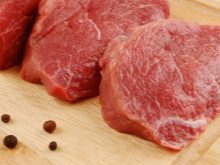

It is recommended to feed puppies at the age of 1.5-2 months about 6 times a day in small portions. By six months, the number of feedings is gradually reduced so that it stops at around 3 times a day. Due to the peculiarities of the physique of English Bulldogs, cereals, as well as vegetables and unsweetened fruits, should prevail in the diet of young dogs.
After a year, the dog is transferred to an adult diet. During this period, at least 70% of the food offered should be lean meat, a couple of times a week it can be replaced with high-quality offal (liver, heart, jellied meat from chicken legs).
The remaining 30% are cereals, raw and boiled vegetables, chicken eggs and sea fish.
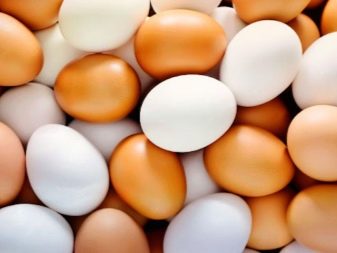
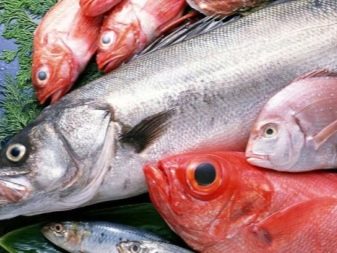
When feeding with natural products, the dog requires vitamins and minerals. Veterinarians recommend purchasing ready-made preparations from pharmacies that contain the necessary additives to the diet of the English Bulldog. Some breeders prefer to feed their dogs dry food, however, in the case of English Bulldogs, this decision can not be called the right one.
The fact is that due to the physiological features of the structure of the jaws and the chewing apparatus, it is difficult for these pets to capture food pellets, so they simply swallow it, which has the most negative effect on the digestive processes in the dog's body.
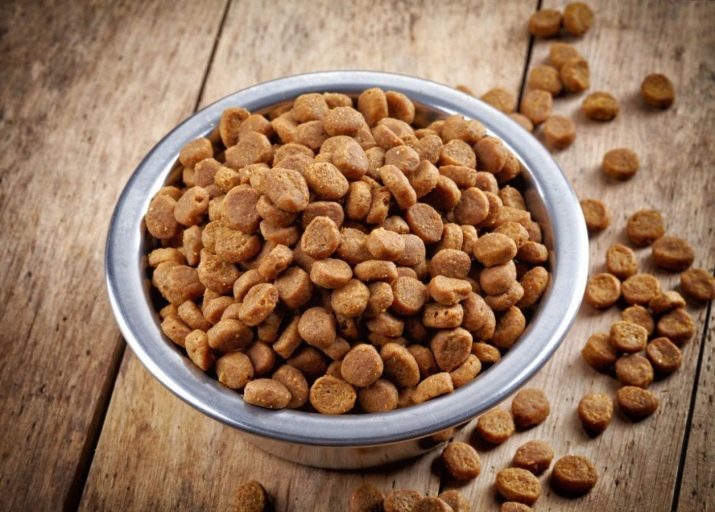
Upbringing
English Bulldogs are easily trained, but it is better to practice it from an early age, otherwise the natural stubbornness makes the dogs extremely intractable. Please be aware that only a strong person with a very firm and at the same time patient character can teach representatives of this breed the rules of behavior. Otherwise, you simply will not be able to cope with the "Englishman" who is unlikely to want to voluntarily overcome his laziness.
The parenting process usually begins with leash training - it should be neither long nor short. Many inexperienced owners believe that the shorter the leash, the easier it will be to keep the dog close to them, but this is a common misconception.
In such a situation, the dog will simply start to break free, and there will be no question of any obedience.
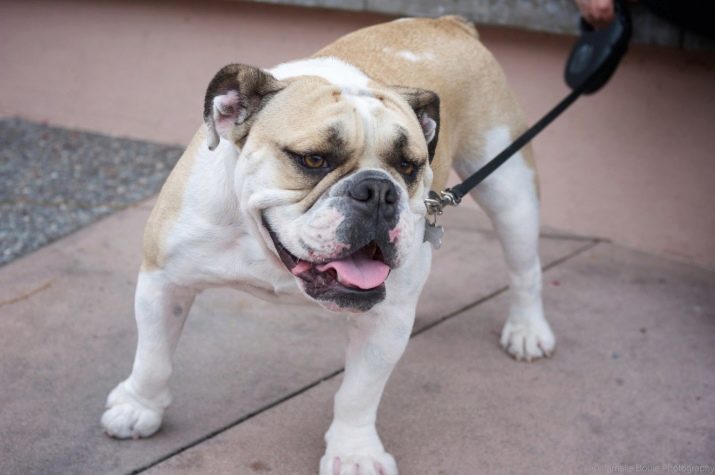
The optimal leash length is 2-2.5 m. Having put it on the dog, it is necessary to start moving forward, giving the command to the dog “near”. At the same time, the bulldog should walk on the left side, keeping up with you and not running away. Once your pet learns to walk in a straight line correctly, you can start learning turns and then a full turn.
When you stop, you should teach the animal to sit down. To do this, he is given the command to "sit", accompanying it with a light hand pressing on the dog's croup. Usually a bulldog needs a few lessons to understand: as soon as the owner gets up, you need to sit down right there, even if the person does not utter the command. In addition, the course of education and training includes building blocks for learning aporting and restraining commands.
Keep in mind that when training a dog, in no case should you raise your voice to him, and even more so apply physical measures. You need to act firmly, but respectfully - only then training will have the desired effect.
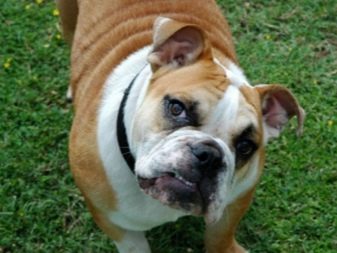
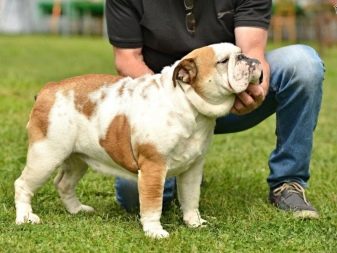
Popular nicknames
English bulldog boys are most often called: Ernie, Rudolph, Hardy, Casper, Adrian, Roquefort, Cliff, Norman, Olympus, Bim, Parker, Pike, Clyde, Diesel, Rudy, Justin, Manny, Alvin, Tyson, Zeus, Troy, Rex, Chester, Chuck, Tiberius, Onyx, Dante, Walt, Toby, Butler, Mac. Nicknames are suitable for girls: Lex, Chelsea, Sheila, Nika, Adele, Amber, Dana, Penny, Dina, Jesse, Richie, Molly, Chloe, Bella, Lucky, Zlata, Assol, Gloria and other noble and sonorous names.

English Bulldog in art
Since the beginning of the last century, English Bulldogs have been firmly associated with the image of good old England, a little prim and patriarchal. The inhabitants of foggy Albion themselves consider the dogs of this breed to be their unofficial symbol of the nation, along with the Scarlet Rose, the Robin bird and the Lion, personifying the English throne.
The similarity of bulldog traits with the traits of a classic English gentleman - calmness, endurance, determination in combination and incredible courage and self-confidence made the image of dogs on propaganda posters and patriotic pictures popular. By the way, it was in the form of a bulldog that one of the most famous British politicians, Winston Churchill, was usually portrayed.
It should be noted that the image of this powerful animal was widely used by writers and filmmakers when it was necessary to introduce into the work the typical national flavor of old England.
For example, in the films about Sherlock Holmes, the English Bulldog played the role of a detective's pet. In the domestic tape about the famous English detective, there were also bulldogs - the personal pet of the leading actor Vasily Livanov, nicknamed Baula, even took part in the adaptation of the story "The Treasures of Agra".
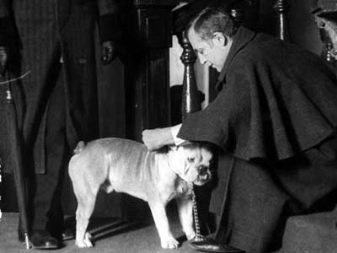
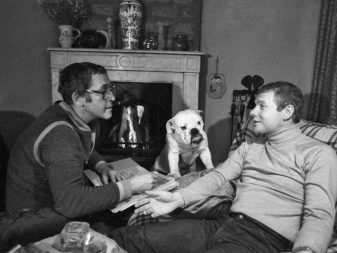
It was the dog of this breed that played a truly key role in the work of J. London "White Fang". He became the only dog who managed to defeat the main character. In K. Brand's detective novels, an English bulldog also became one of the acting characters, who helped its owner to take an active part in the search for criminals. These dogs also appeared in the role of detectives in the book "Sisters of Lies" by K. L. Taylor.
A bulldog named Rvun occupies a central place in the work of M.Rawlings "Peers", June's pet became the hero of one of the small works of the Russian writer I. Tsareva, dogs of this ancient breed were noted on the pages of Kern's book "Ferdinand the Magnificent", D. Steele "The Second Attempt", as well as J. Grabowski "A Fly with Whims ". Bulldogs were also mentioned by Lev Tolstoy - in the work "The Third Russian Book for Reading", readers get to know the charming bulldog Bulka.
Over the past decades, the image of these animals has become firmly established in mass culture. Sports teams, computer games and musical groups began to be named after them. English Bulldogs are used in the names of some types of weapons, the names of some brands and brands.
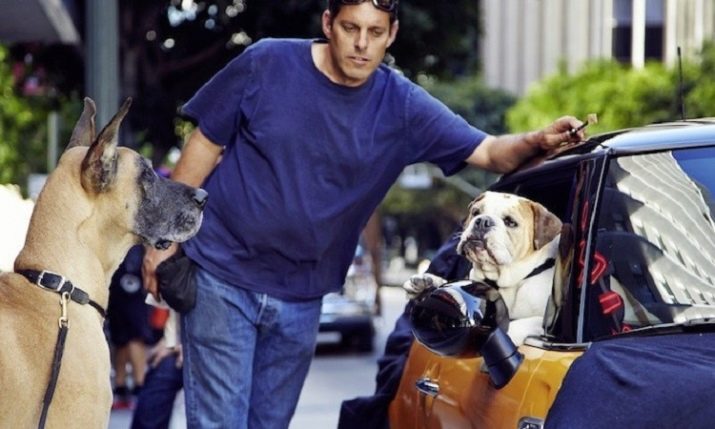
Painters also played a significant role in the Bulldogs. Especially many works were dedicated to them at the end of the 17th century. So, the painting by G. Cloves "Portrait of a Bulldog Pain in a Landscape" received great fame.
Moreover, it is known that the society of bulldog lovers in the United States even owns its own art gallery, while it is regularly updated.
Bulldogs have always been a source of inspiration for popular music artists, for example, the legendary Beatles even included the track Hey Bulldog on their Yellow Submarine album, and one of America's most popular punk bands is even called the Bulldogs. These animals often become cartoon characters. They were the ones who appeared before the audience in The Life of This Guy, The Hipsters, the films Trezor and Mister Magu.

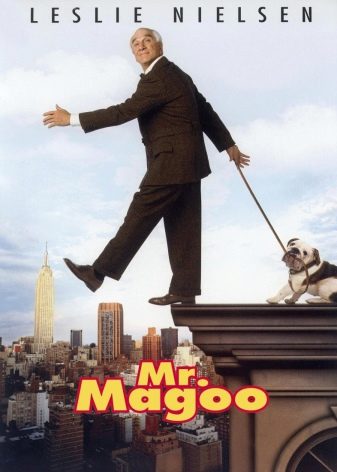
Owner reviews
According to the reviews of the owners, English Bulldogs are extremely intelligent, intelligent dogs, however, they need constant and continuous development of their abilities. These are very stubborn and at the same time extremely phlegmatic pets who require a little patience, attention and delicate perseverance from their owners.
The appearance of these unusual dogs often makes the owners "flinch" and "give slack". This cannot be done, since the animal instantly feels it and immediately "sits on the neck" of its owner, starting to manipulate him. This is why it is so important constantly show who is in charge of the house, however, this must be done tactfully and delicately.
This breed is very popular, but many owners do not take into account the nature and temperament of the animals when buying. Meanwhile, the voice of the ancestors makes itself felt. The result of such thoughtless breeding was a sharp increase in the number of aggressive representatives of the breed. This happens especially often in unknown nurseries, therefore When buying an English Bulldog puppy, you must make sure of the seller's reliability and communicate with the dog personally.
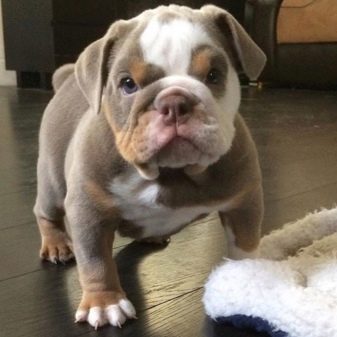
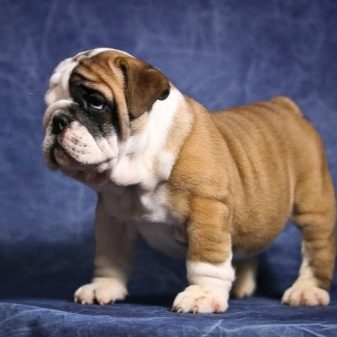
Whatever is said about the breed characteristics in general, each animal always has its own characteristics. The cost of puppies directly depends on their class. So, pet-class dogs that will become beloved pets, loyal friends and reliable companions, but at the same time will not be able to participate in competitions and be used for further breeding, are estimated at 10-20 thousand rubles (2019). For this price, the dog usually has no pedigree.
If you need a show class pet, then you need to be ready to part with a much larger amount - from 30 to 60 thousand rubles (2019). It must be said that the days when English Bulldogs were considered dangerous fighting dogs are over.
Thanks to the efforts of dog handlers and proper upbringing, these animals today have lost their aggression, have become calm, phlegmatic and restrained dogs, thanks to which they have become one of the most popular breeds in the world.
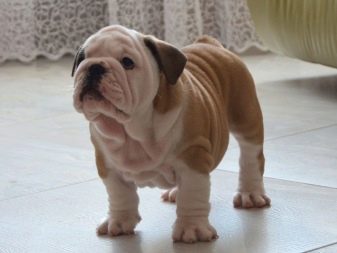
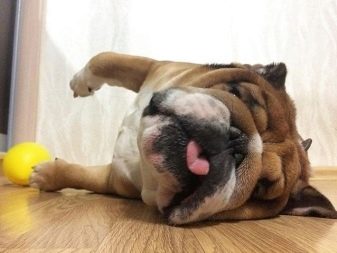
For the characteristics of the breed, see the following video.

































